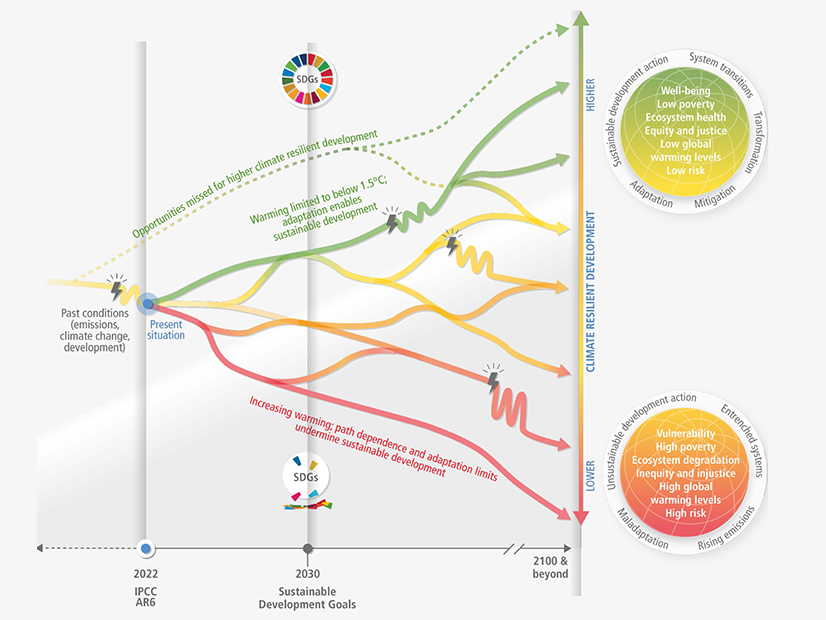
The latest report from the U.N. Intergovernmental Panel on Climate Change (IPCC) carries a stark and urgent warning: The intensifying impacts of climate change are outpacing nature’s and societies’ abilities to adapt to or mitigate them.
Further, the report says, humans’ reactions — or lack of reactions — to climate change can increase the vulnerabilities already being caused by “the dynamic interactions among climate-related hazards.”
In the U.S., higher temperatures could “increase power system costs by about $50 billion by the year 2050,” the report says.
Heat waves could trigger soaring power prices in spot markets, with heavy impacts for low-income and disadvantaged consumers, the report says. Similarly, disruptions to weather patterns can also affect demand peaks and curves as residential and commercial customers respond to short-term “weather shocks” and longer-term changes.
“The energy system is really integral to thinking about the entire climate change issue,” said Delavane Diaz, a project manager at the Electric Power Research Institute (EPRI), who worked on the IPCC report.
Electricity systems can be especially vulnerable to extreme weather events, Diaz said.
“Depending on the climate impact driver, whether it’s extreme heat or flooding or wildfire, it can affect all elements of the system,” she said, from upstream fuel supplies to generation to consumption patterns.
Other power system vulnerabilities identified in the report include:
- the impact of drought on water supplies, not only for hydropower generation but for the cooling systems needed for fossil fuel plants;
- reduced output from photovoltaic solar panels in high and extreme heat as well as the potential need for additional cleaning of panels because of wind-blown sand. Rising temperatures could result in a 1% decrease in solar power production per year until 2049, the report says;
- potential damage to distribution and transmission lines caused by extreme weather events, resulting in longer and more frequent power outages, with disadvantaged communities disproportionately affected.
“Increases in windstorm frequency and intensity increase the risk of direct damage to overhead lines and pylons,” the report says. “Where the mode of failure is recorded, transmission pylons are seen to be more susceptible to wind damage, whilst distribution pylons are more likely to be affected by treefall and debris.”
Climate-resilient Development
The IPCC report’s 3,675 pages are largely focused on the environmental impacts of climate change and the cascading effects that disruptions in one sector can have across others.
“This report recognizes the interdependence of climate, biodiversity and people and integrates natural, social and economic sciences more strongly than earlier IPCC assessments,” IPCC Chair Hoesung Lee said. “It emphasizes the urgency of immediate and more ambitious action to address climate risks. Half measures are no longer an option.”
For example, the report predicts that ongoing climate-related disruptions to supply chains and trade will cause “large market and non-market damages” to the North American economy.
The report’s big-picture solution is a call for “climate-resilient development,” which Diaz described as “kind of integrating both the climate impacts and the potential for adaptation responses into the same planning process.”
“So, when you think about the electric power system, we want to be able to plan for future conditions in terms of maybe the temperature distribution shifting or the frequency of extreme events maybe increasing,” she said. “It’s both accounting for the changes that are linked to climate change at the same time as integrating adaptation options, which could include changes to the technologies themselves or the way that they are operated.”
Debra Roberts, co-chair of the IPCC working group that produced the report, also stressed the importance of holistic solutions. “Tackling all these different challenges involves everyone — governments, the private sector, civil society — working together to prioritize risk reduction, as well as equity and justice, in decision-making and investment,” Roberts said.
“By bringing together scientific and technological know-how as well as Indigenous and local knowledge, solutions will be more effective,” she said.
Limits to Adaption
Environmental groups echoed the reports warnings and its call to action.
“Even small increases in warming can multiply harmful impacts in the future,” said Daniel Bresette, executive director of the Environmental and Energy Study Institute. “But that does not mean our situation is hopeless. We have a small window of time to act, so we need to act now.”
Cherelle Blazer, senior director of the Sierra Club’s International Climate and Policy Campaign, called on Congress to pass strong climate legislation — without specifically mentioning the stalled Build Back Better Act.
“Each day that passes without Congress passing legislation investing in climate, jobs and justice is another day of needless stress and suffering for millions of people in the U.S. and abroad,” Blazer said. “There are limits to adaptation, and a stark pivot away from the fossil fuel economy to clean, renewable energy is required.”
At the same time, Diaz believes that the U.S. energy sector should not only look at the future through a climate lens, but should also include factors like decarbonization policy, technological innovation and socio-economic trends.
“It’s not to say that climate change isn’t a priority, but it really needs to be looked at in an integrated setting because these factors can interact with each other,” she said. “Simply trying to impose a future climate projection on the current system misses all of these other elements.”


